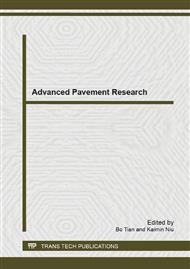p.200
p.204
p.212
p.222
p.227
p.232
p.239
p.248
p.259
Effect of Base Parameters on Mechanical Properties of Cement Concrete Pavement Considering Interlayer Contact
Abstract:
Three-dimensional structure model on Winkler foundation considering inter layer contact status was established. The effect that base modulus, thickness and inter layer contact status between slab and base to maximum stress of slab bottom and base bottom, shear stress between slab and base, warping of slab was calculated. The results showed that: interlayer contact status had great influence on slab stress and warping. Maximum stress of slab bottom dropped while bonding status decreased and slab warping increased obviously while bonding status weakened. Base modulus was the primary factor for base stress. Maximum stress of base bottom increased while modulus increased, and decreased while bonding status weakened. Interlayer shear stress occurred mainly at slab edge, and decreased while the bonding status weakened, almost had no correlation to base modulus and thickness.
Info:
Periodical:
Pages:
227-231
Citation:
Online since:
December 2013
Authors:
Price:
Сopyright:
© 2014 Trans Tech Publications Ltd. All Rights Reserved
Share:
Citation:


